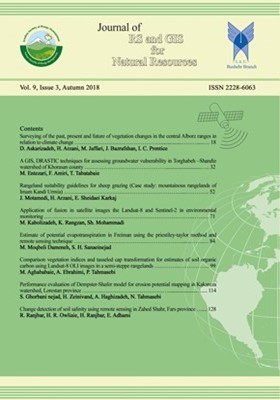Estimate of potential evapotranspiration in Freiman using the priestiley-taylor method and remote sensing technique
Subject Areas : Geospatial systems development
Mosayeb Moqbeli Dameneh
1
![]() ,
Seyed Hossein Sanaeinejad
2
,
Seyed Hossein Sanaeinejad
2
1 - PhD Student of Agricultural Meteorology, Department of Agriculture, Ferdowsi University of Mashhad
2 - Assoc. Prof. College of Water Engineering, Department of Agriculture, Ferdowsi University of Mashhad
Keywords: Potential evapotranspiration, Priestley-Taylor, Khorasan Razavi, remote sensing,
Abstract :
Evapotranspiration is one of the important components of water balance which is measured and estimated by several methods. Since these methods mainly involve point-by-point measuring and requiring a large amount of grounded data, so they have limitations. In this study, potential evapotranspiration for 8 days in 2014, 2015 and 2016 was estimated using the Priestley-Taylor method and remote sensing technique in Fariman area in Khorasan Razavi province using Landsat 8 Operational Land Imager (OLI). To determine the accuracy of the estimates, the results of this study were compared with the FAO Penman-Monteith method (the reference method for estimating potential evapotranspiration). Comparison of the obtained results by the Priestley-Taylor method with the FAO Penman-Monteith method showed that the R2 and Root Mean Square Error (RMSE) are 0.91 and 0.78 mm/d, respectively. This result indicates that the high accuracy of this method in estimating potential evapotranspiration in a semi-arid climate.
بابامیری، ا.، ی. دین پژوه و ا. اسدی. 1392. واسنجی و ارزیابی هفت روش تخمین تبخیر- تعرق گیاه مرجع مبتنی برتابش خورشیدی در حوزه آبریز دریاچه ارومیه. نشریه دانش آبوخاک، 23(4): 143-158.
حسینی، ا. 1393. تعیین تبخیر-تعرق پتانسیل با استفاده از تصاویر ماهوارهای در مناطق مرکزی یزد. پایاننامه کارشناسی ارشد مهندسی منابع طبیعی. دانشکده منابع طبیعی. دانشگاه یزد. 110 صفحه.
عصاره مستقیم، م.، ع. رحیمی خوب و ل. عصاره مستقیم. 1390. برآورد تبخیر و تعرق مزارع نیشکر با استفاده از مدلهای تجربی تابشی جهت مدیریت منابع آب. یازدهمین سمینار سراسری آبیاری و کاهش تبخیر. کرمان-دانشگاه شهید باهنر، 18 الی 20 بهمنماه. 2600 صفحه.
مؤذنزاده، ر. 1392. پایش سیستم هیدرولوژیک حوزه آبریز نیشابور با استفاده از تکنیک سنجشازدور. پایاننامه دکتری مهندسی آب. دانشکده کشاورزی. دانشگاه فردوسی مشهد. 175 صفحه.
Barik MG. 2014. Remote sensing-based estimates of potential evapotranspiration for hydrologic modeling in the upper Colorado River basin region. PhD degree in Civil Engineering, UCLA, University of California, 131 pp.
Bastiaanssen WG, Menenti M, Feddes R, Holtslag A. 1998. A remote sensing surface energy balance algorithm for land (SEBAL). 1. Formulation. Journal of Hydrology, 212: 198-212.
Bisht G, Venturini V, Islam S, Jiang L. 2005. Estimation of the net radiation using MODIS (Moderate Resolution Imaging Spectroradiometer) data for clear sky days. Remote Sensing of Environment, 97(1): 52-67.
Brutsaert W. 2013. Evaporation into the Atmosphere: Theory, History and Applications. Springer Science & Business Media, Netherlands, 302 pp.
Da Silva BB, Montenegro SMGL, da Silva VdPR, da Rocha HR, Galvíncio JD, de Oliveira LMM. 2015. Determination of instantaneous and daily net radiation from TM–Landsat 5 data in a subtropical watershed. Journal of Atmospheric and Solar-Terrestrial Physics, 135: 42-49.
Flint AL, Childs SW. 1991. Use of the Priestley-Taylor evaporation equation for soil water limited conditions in a small forest clearcut. Agricultural and Forest Meteorology, 56(3-4): 247-260.
Holtslag A, Van Ulden A. 1983. A simple scheme for daytime estimates of the surface fluxes from routine weather data. Journal of Climate and Applied Meteorology, 22(4): 517-529.
Hwang K, Choi M, Lee SO, Seo J-W. 2013. Estimation of instantaneous and daily net radiation from MODIS data under clear sky conditions: a case study in East Asia. Irrigation science, 31(5): 1173-1184.
Idso SB, Jackson RD, Reginato RJ. 1975. Estimating evaporation: a technique adaptable to remote sensing. Science, 189(4207): 991-992.
Jensen ME, Haise HR. 1963. Estimating evapotranspiration from solar radiation. Proceedings of the American Society of Civil Engineers, Journal of the Irrigation and Drainage Division, 89: 15-41.
Karlsson E, Pomade L. 2013. Methods of estimating potential and actual evaporation. Salt Lake City: Department of Water Resources Engineering: 1-11.
Khaldi A, Hamimed A. 2014. Using the Priestley-Taylor expression for estimating actual evapotranspiration from satellite Landsat ETM+ data. Proceedings of the International Association of Hydrological Sciences, 364: 398-403.
Kustas W, Li F, Jackson T, Prueger J, MacPherson J, Wolde M. 2004. Effects of remote sensing pixel resolution on modeled energy flux variability of croplands in Iowa. Remote sensing of Environment, 92(4): 535-547.
Li S, Kang S, Zhang L, Zhang J, Du T, Tong L, Ding R. 2016. Evaluation of six potential evapotranspiration models for estimating crop potential and actual evapotranspiration in arid regions. Journal of Hydrology, 543: 450-461.
Lu J, Sun G, McNulty SG, Amatya DM. 2005. A comparison of six potential evapotranspiration methods for regional use in the southeastern united states 1. JAWRA Journal of the American Water Resources Association, 41(3): 621-633.
Oudin L, Hervieu F, Michel C, Perrin C, Andréassian V, Anctil F, Loumagne C. 2005. Which potential evapotranspiration input for a lumped rainfall–runoff model?: Part 2-Towards a simple and efficient potential evapotranspiration model for rainfall–runoff modelling. Journal of Hydrology, 303(1-4): 290-306.
Priestley C, Taylor R. 1972. On the assessment of surface heat flux and evaporation using large-scale parameters. Monthly Weather Review, 100(2): 81-92.
Rango A. 1994. Application of remote sensing methods to hydrology and water resources. Hydrological Sciences Journal, 39(4): 309-320.
Sandholt I, Rasmussen K, Andersen J. 2002. A simple interpretation of the surface temperature/vegetation index space for assessment of surface moisture status. Remote Sensing of Environment, 79(2-3): 213-224.
Tegos A, Efstratiadis A, Koutsoyiannis D. 2013. A parametric model for potential evapotranspiration estimation based on a simplified formulation of the Penman-Monteith equation. In: Evapotranspiration-An Overview. InTech, DOI: 10.5772/52927.
Thornthwaite CW. 1948. An approach toward a rational classification of climate. Geographical Review, 38(1): 55-94.
Xu C-Y, Singh V. 2002. Cross comparison of empirical equations for calculating potential evapotranspiration with data from Switzerland. Water Resources Management, 16(3): 197-219.
Zhang Y, Liu C, Yu Q, Shen Y, Kendy E, Kondoh A, Tang C, Sun H. 2004. Energy fluxes and the Priestley–Taylor parameter over winter wheat and maize in the North China Plain. Hydrological Processes, 18(12): 2235-2246.
_||_

